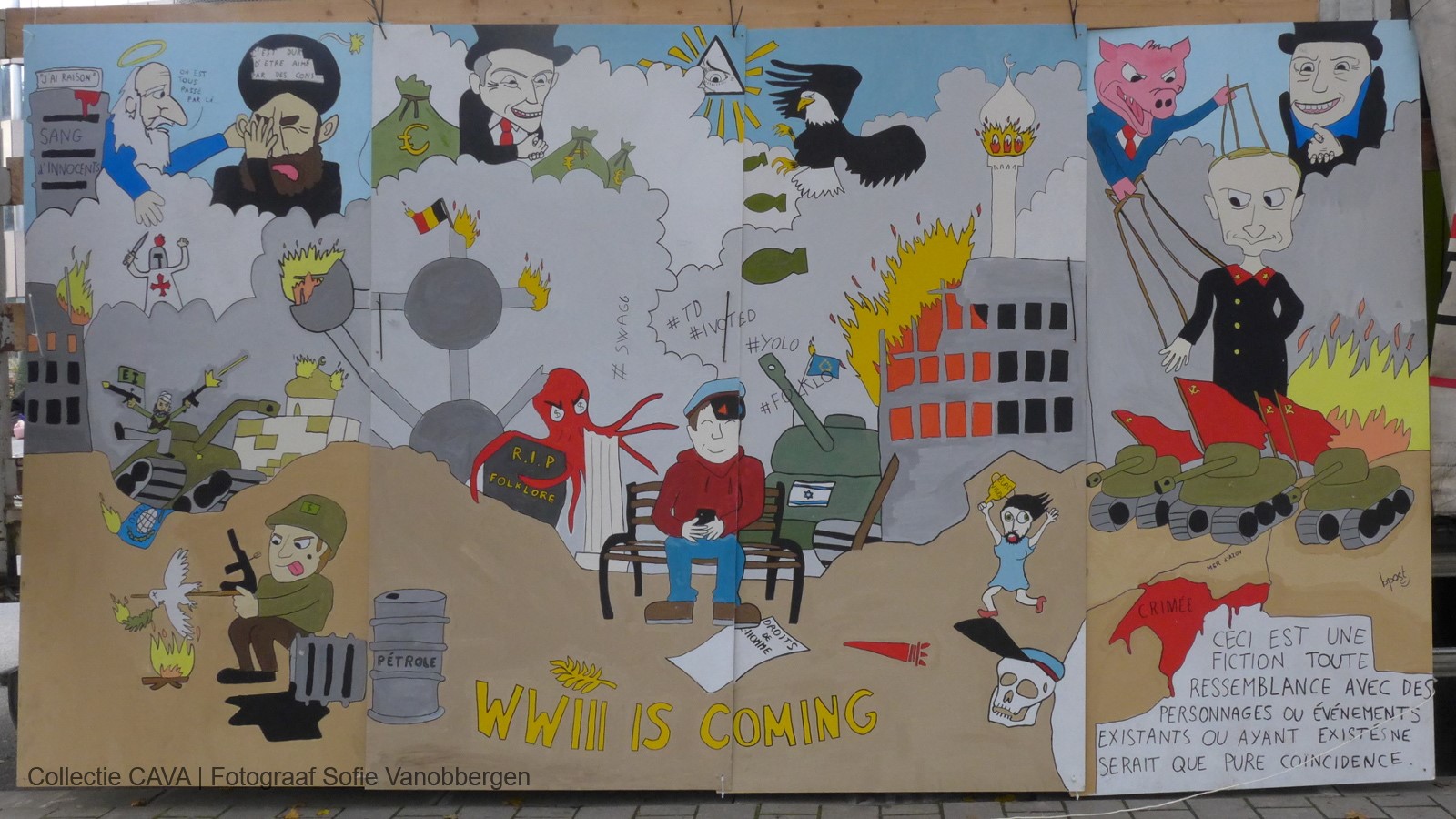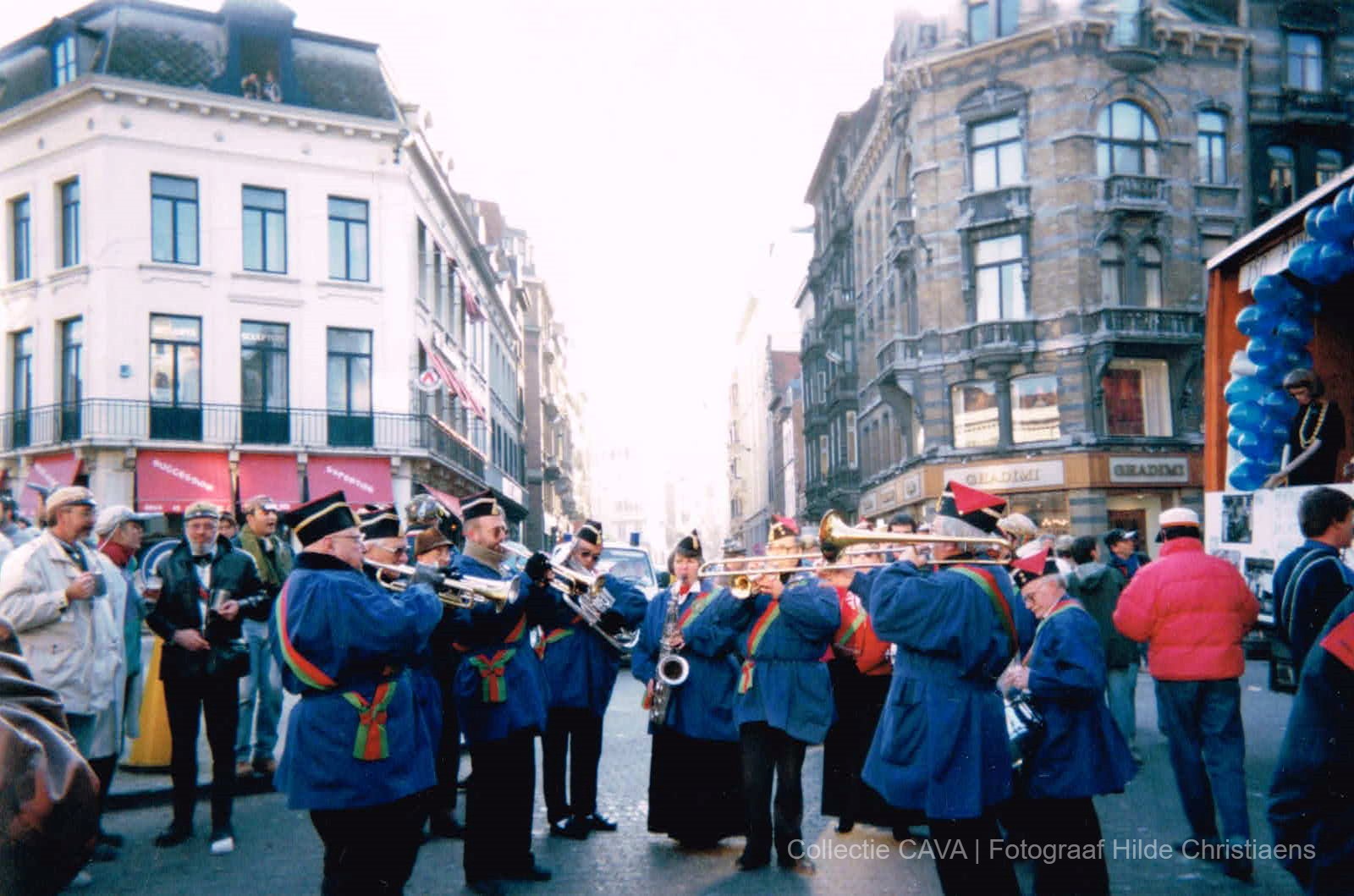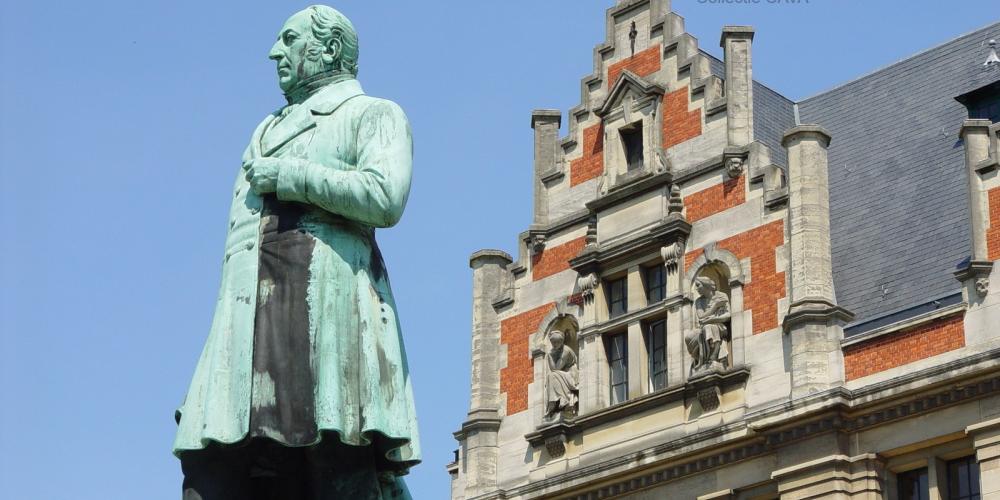
From 1888 onward, on (or around) 20 November ULB and VUB commemorate Pierre-Théodore Verhaegen as the founder of a free and scientific education that is not based on superstition or intolerance. Two years later, the academic authorities joins in on the commemoration ceremony. Over time, this celebration, called Saint V, has changed from a spontaneous protest by a few hundred students to a grand event attended by thousands of people.
Saint V through the Ages
Théodore Verhaegen: the Canonisation of a Founder
On 24 June 1834, Pierre-Théodore Verhaegen attends a banquet of Les Amis Philanthropes, the masonic lodge he belongs to. He launches an emotional appeal for a free university that will be able to serve as a counterweight to the so-called Catholic university. Many of the members agree with Verhaegen and the proposal to found a free university quickly gains momentum. That same year, the Université Libre de Belgique, as the ULB is initially called, opens its doors. The first academic year starts on 20 November.
(Article continues below image)
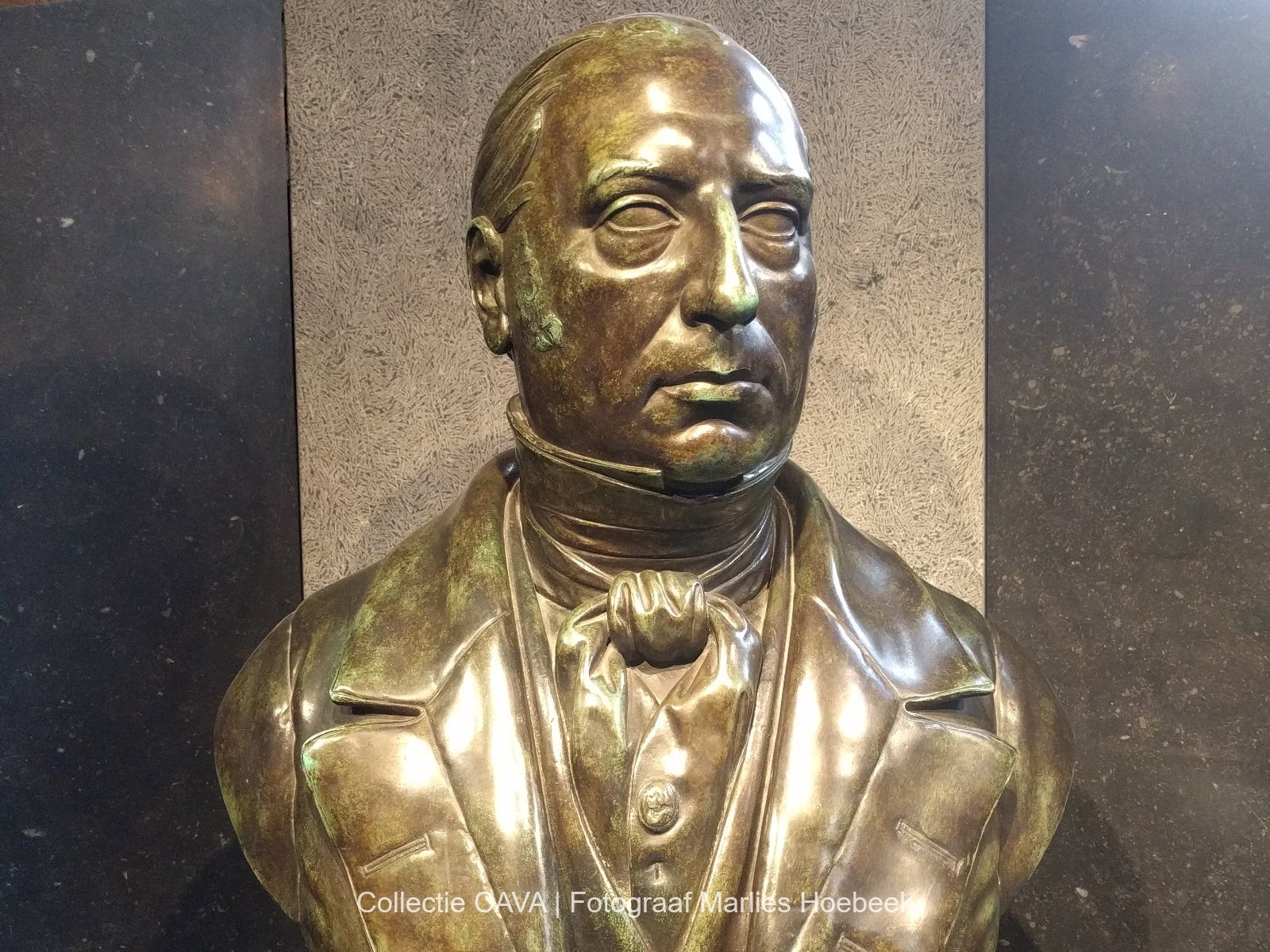
From the very beginning, students and staff of the ULB get the day off on 20 November. Upon its foundation in 1843, the Union des Anciens Etudiants immediately takes the initiative to meet up with ULB alumni in the bars of Brussels on this day. On 20 November 1884, the ULB celebrates its 50th anniversary and organises a big celebration in Brussels.
In 1888, the students use their day off to take a stand. Unhappy with the dogmatic and closed-minded attitude of their professors and the directors of the university, 200 of the 1.400 enrolled students gather at the statue of Verhaegen that day. There, the president of the Société Générale des Etudiants, Accarain, takes the floor. In his speech, he stresses the great respect and admiration the students have for Verhaegen, the man who vehemently denounced the influence of the church on the state, science and higher education and who helped reduce the harmful influence of the episcopate.
After the speech, the students make their way to the cemetery to place a wreath at the grave of their ‘idol’. Inspired by the solemnity of this event, the press refers to a ‘canonisation’. The liberal student gazette ‘L’Etudiant’ eagerly adopts this idea: ‘Saint’ Verhaegen is born.
A Walk in the Belle Époque
During the Belle Époque the ceremonial and collegiate aspect go hand in hand. The ‘Journal des Étudiants’ mentions no less than six separate processions on 19 and 20 November 1901. Students in their Sunday best parade through the streets of Brussels and listen to speeches at several locations. On 21 November the students dial it down a bit: after a walk through Parc Léopold, they play games and attend a matinee performance. The day ends with a banquet at Trois Suisses, a café next to La Monnaie. It isn’t until the 1920s, when the ULB moves to its campus in Ixelles, that a clear distinction will be made between the ceremonial part of the day and the procession.
It doesn’t take long for Saint V to become a staple of the academic year. Every year since the first commemoration, Saint V has been celebrated on 20 November, unless it falls on a Saturday or on a Sunday… or unless an important football game takes place in Brussels, in which case Saint V is celebrated on another day.
Commemorating, Despite Challenging Circumstances
Even during both world wars, the students adhere to the tradition of Saint V as best they can. During World War I, the students and alumni gather in De Panne to celebrate Saint V. In 1939, 1940 and 1941 the procession is replaced by a collection for the families and children of mobilised soldiers. To this day, the ‘quête sociale’ is an inherent part of Saint V. In the days leading up to Saint V, students beg in the streets; part of the money they earn this way goes to charity. In 1942 and 1943, Saint V is celebrated in exile: the first year a banquet is held in Hotel Rembrandt in London; the next year students and alumni gather at the London School of Medicine. Celebrations are also held in New York, Lisbon and the Congo. When the ULB reopens its doors in 1944, it’s a sombre procession that makes its way to the statue of Verhaegen, the Tomb of the Unknown Soldier and the statue of Francisco Ferrer. It’s not until 1945 that the typical procession again winds its way through the streets of Brussels, after a six year absence.
Carrying Out a Message
Since the 50s of last century, every single Saint V has a theme that refers to current events. Students express their displeasure with specific deplorable issues and mock bourgeois culture. Anticlerical themes, criticism of totalitarianism (fascism: 1936, 1938), social injustice and political problems (the School Wars: 1955) are all treated extensively.
Saint V is also the perfect moment for students to reinforce their requests and to take (political) action. In 1956, Marc Bafcop, president of the Brussels Studentengenootschap (BSG), argues that for a century Flemish students have fought an unequal and oftentimes hopeless battle for equality and equal rights and that this struggle continues. Another BSG president, Hendrik Peeters, also uses his right to speak at Saint V to plead for a further duplication of the university along linguistic lines. His speech on Saint V, he argues, caused great dismay, but also found great resonance. His message is picked up by the press. Mike Collard, president in 1967/68, refuses to speak when given the floor by the ULB authorities. His speech does, however, appear in the press and creates quite a furore. In it, Collard denounces the arrogance of the Board of the ULB with regards to the linguistic duplication. The recurring call for a Dutch-language university in Brussels will in 1969 result in the establishment of the Vrije Universiteit Brussel.
Six years later, emotions run high after the draft law Humblet-De Croo regarding the funding of university education is made public. The students decide not to organise a Saint V procession, but to hold a memorial service at the Sablon. It’s the first time since the Second World War that the procession doesn’t take place. All student societies – both political and non-political – unite. A coffin is carried through the crowd.
(Article continues below image)

Abortion (1981), apartheid (1985), human rights (1988, 1998), freedom of speech (1989), patriotism (2007), migration (2017) are but a few of the themes of Saint V. The speeches, banners and decors show a clear commitment: the students strive for a better world, where there is no place for injustice. And they definitely do not spare their own universities.
(Article continues below image)
For the 50th, 75th and 100th anniversary of the university, a remembrance medallion is issued by the Association Générale des Etudiants. Each year since 1938, the BSG and the Association des Cercles Étudiants (the new incarnation of the Association des Cercles Facultaires) jointly issue an official medallion for Saint V. They ask creative sympathisers for designs, which are then discussed at length. The chosen design is adapted according to the wishes of everyone involved. The medallions display the themes in a nonconformist way, which means that they regularly stir things up.
Different versions of the medallions are often made (in different colours, or because there’s a jubilee). Quite a few student societies and groups make their own version of the official medallion or create a separate design – these are called pirate medallions. Students usually pin these medallions on their caps, but over the years the medallions have also become coveted collector’s items in their own right. Every year several collectors gather at the Sablon to trade, buy and sell medallions.
(Article continues below image)
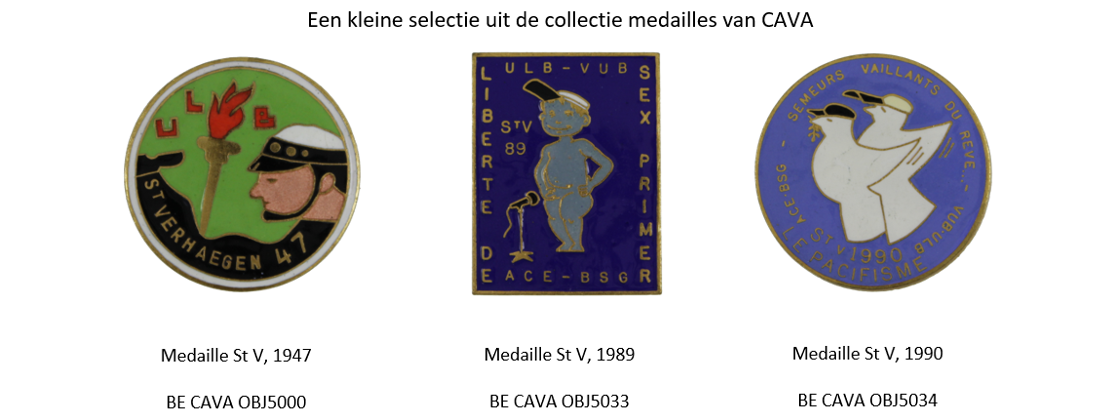
“Ne touche pas à mon Saint-V!”
After the terrorist attacks in Paris on 13 November 2015 and a negative recommendation by the local police department, the City of Brussels decides to cancel the procession for security reasons. The morning ceremony takes place as usual. The student societies reject the idea of an alternative party at the Heysel, because it doesn’t take into account the deeper meaning of Saint V. The students refuse to give in to fear, terror and extremism and send a clear signal: Saint V should take place in the city centre. Armed with banners that spell out ‘No Fear’ and ‘Ne touch pas à mon Saint V’, a few hundred students gather at the Sablon, showing their resistance to all attempts to limit their freedom. The joint press release states that both the university authorities and the students refuse to give way to fear and will not let liberties and festive traditions be taken away. A few years later, current rector Caroline Pauwels looks back on this edition as one of the most bonding Saint V’s, that showed the essence of the celebration: quiet resistance and thought that must never submit.
(Article continues below image)
Because of Safety Level 3 and the Plan Mayeur, the traditional parade with trucks doesn’t take place either in 2016. The afternoon program is reduced to a party at the Sablon. The ‘party village’ is expanded throughout the next few years, but not everyone is happy with the new formula. Nicolas Dutré, president of the Oudstudentenbond, lashes out. He calls present day Saint V a watered down, boozy parade that has lost touch with its socially critical origins. Frans Van Kalken, almost a century before, lamented in a similar fashion the way the values of Saint V had eroded. He complained that while the founder of the university deserved all the praise he had gotten, that praise had gotten a little too mechanical and not conscious enough.
Nevertheless, the universities and several student and alumni societies take steps to explain the meaning of Saint V to new generations of students and to reiterate the practices, values and norms of the universities. Each year, they touch upon subjects such as Théodore Verhaegen, free inquiry, the values of the Age of Enlightenment and humanism.
The more, the merrier
From a Local Celebration…
Several thousands of people participate in Saint V each year: a few hundred attend the ceremonial part in the morning, while thousands gather at the Sablon in the afternoon. Different generations of students, alumni and staff members meet each other there. Not only the students from Brussels celebrate Saint V: students from other university towns also come to the capital to join in on the celebration.
Brussels is very important for the students, alumni and sympathisers that celebrate Saint V. Each year, on 20 November, several places of memory are visited. The route of the procession through the streets of Brussels changed several times over the years, but remains a typical phenomenon of Brussels. Its importance is illustrated by the symbolic end to the morning at the Brussels Town Hall and the visit to Manneken Pis, whose reference value for the participants is high.
Je n'ai raté que quelques cortèges. Lorsque je reviens, je retrouve à chaque fois de vieux copains, ce qui me permet de garder leur contact. C'est une fête moderne, mais qui respecte les traditions, ce qui me plaît énormément
- Freddy Thielemans in 2001
In 1921, Manneken Pis is proclaimed an ‘ancien étudiant’ of the ULB and is given his first student togs. Sadly, this first costume was stolen, but in 2001 a copy of the suit is donated. From then on, ‘le petit Julien’ is able to once more attend Saint V in full regalia (i.e. in his lab coat and student cap). According to Freddy Thielemans, then mayor of the City of Brussels, Costume N° 9 (N° 690) shows the continuity of the university in the city.
Woltje, maybe the best known marionette of Toone, the royal puppet theatre, is also outfitted in a student costume and baptised with beer by none other than Manneken Pis himself, who is dressed as a ‘comitard’ of the ULB for the occasion.
Tall tales abound as to how some male students identified with Manneken Pis to such an extent that they started imitating the statue, much to the consternation of passers-by. In order to limit the disturbance of the peace, Manneken Pis is no longer a stop on the official route.
Since the early 20th century foreigners have participated in Saint V. In 1901 foreign delegations are picked up at the Brussels-North railway station and brought to the city centre in a festive procession. There they are treated to an evening of speeches, recitations and music. For the 1909 edition, several celebrities travel to Brussels, like Henri Poincaré (Paris) and Francis Darwin (Cambridge). And in 1930 Costa Rican students lay flowers at the statue of Verhaegen.
The Saint V celebrations aren’t confined to the Brussels Capital Region. Saint V is celebrated in quite a few Belgian cities: from Ath, Charleroi and Mons to Waterloo. Saint V is also celebrated abroad: every year in November, brunches, banquets and other gatherings are organised by the international branches of the alumni associations: in Beirut (Lebanon), Léopoldville/Kinshasa (DRC), London (UK), New York (USA) and Paris (France).
No Such Thing as an Average Saint V
Today, the program for the day remains more or less the same, but throughout the years there have been several variations and evolutions. Current affairs often determine which elements of the celebration are repeated year after year, and which are added or scratched. Saint V evolves to this day. The spirit of Saint V is that each and every generation can make it its own and that the celebration adapts to changing circumstances.
Homages and Tributes
Saint V not only honours Saint Verhaegen, but also many other persons. The community pays tribute to those who were instrumental in the establishment of the university and who promoted its values. The community likewise pays homage to those who gave their lives to protect these very values.
Until the 1960s, a visit was made in the morning to the Tomb of the Unknown Soldier. Nowadays, Saint V kicks off with a shared breakfast on campus, after which buses take the participants to the National shooting range. At the Enclos des Fusillés the members of the resistance who died for their country are honoured – among them ULB students like Arnaud Fraiteur and the brothers Livchitz.
(Article continues below image)

Next, flowers are placed at the grave of Théodore Verhaegen at the cemetery of Brussels. A few years ago, an old tradition, dating back to 1945, was revived: nowadays flowers are laid once more on the grave of Frans Kufferath, a ULB student who perished on 11 May 1940 during the Battle of Fort Eben-Emael. ‘Kuff’ used to be a member of the Cercle Polytechnique and is depicted on his headstone with his student cap. He symbolises all students who died as a soldier or as a member of the resistance.
Subsequently, the participants head to the campus Solbosch, where they lay flowers at the monument remembering the victims of barbarism. Since 1997 they also gather at Square G, where the ULB erected a monument for Groupe G in 1996. This resistance group grew out of the Cercle du Libre Examen and was founded by former ULB students, alumni and teachers like Jean Burgers, Robert Leclerq, Richard Altenhoff and Henri Neuman.
Since the early beginning in 1888 the participants gather at the statue of Théodore Verhaegen. This remains a constant. Since 1984, tribute is paid once more at the statue of the Spanish educationist Francisco Ferrer, who symbolises free thought, intellectual freedom and rationalist education. His statue was inaugurated a first time in 1911, but was placed in front of the rectoral building of the ULB for its 150th anniversary.
(Article continues below image)
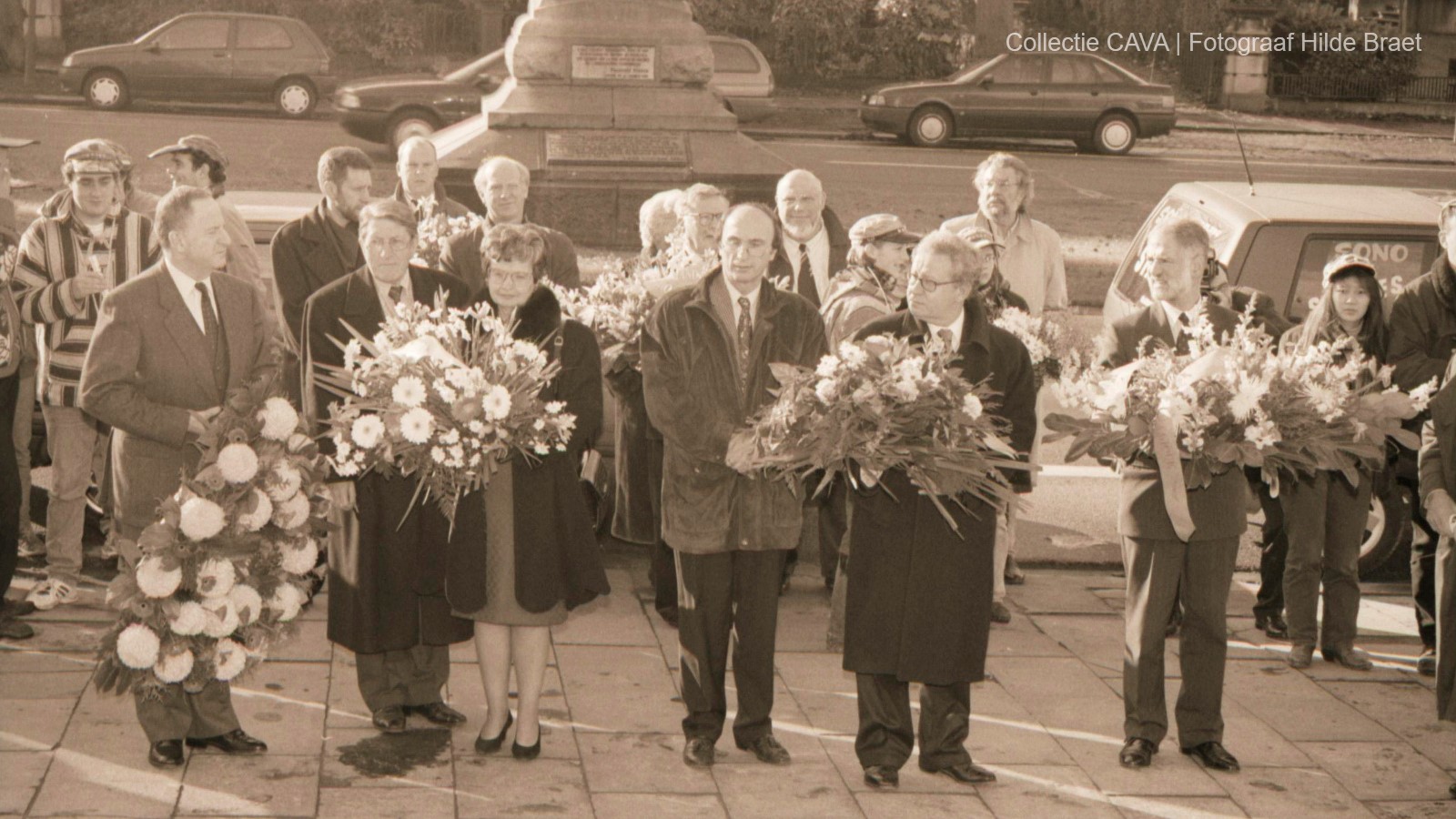
The morning program of Saint V ends with a joint session of the VUB and the ULB in the Gothic Hall of the City Hall of Brussels. There, the attendees raise the Glass of Friendship in the courtyard or in the Militia Hall.
Changing Course
The route of the procession also changes regularly. Sometimes the route is adjusted because of road works or at the request of the police. For many years, the procession has disbanded at the Bourse, but this hasn’t always been the case: in earlier times it ended at the Porte de Namur, the Place Poelaert and the Place de Brouckère.
Now that motorised vehicles are no longer part of the Saint V procession, a procession precedes the actual procession. This ‘Marche des étudiants’ is organized for students who do not travel to the Sablon by public transport. It is organised by Folklore Academie, the collective that watches over student traditions at the VUB. At 10:33 a.m. the students of the VUB gather in front of building M. The marche itself punctually leaves at 11:03 a.m. and heads towards the Grand Sablon, via the Avenue de la Couronne and the Rue du Trône.
At the Grand Sablon, all sections meet up again: first-year students and many other generations of students and alumni of the VUB and the ULB (including some dignitaries of the City of Brussels), the academic authorities, as well as student delegations from other colleges and universities. It is the perfect place and time to catch up. The presidents of the student societies show up in their togas, the students in their student caps and lab coats. They carry the flags of their societies. The alumni also dust off their caps for the occasion.
(Article continues below image)

The Sablon is a symbol of ‘gueux’ culture (during the Dutch Revolt, the covenant of members of the lesser nobility who in 1566 submitted a petition to the regent to suspend persecution for heresy in the Habsburg Netherlands, were called Beggars – ‘gueux’ in French). The palace of one of the most important leaders of the Beggars, the Count of Egmont, was located at the (Petit) Sablon. A statue of the Counts of Egmont and Horn, who were beheaded in Brussels, was placed at this location. Because the secular humanists identify with the gueux rebels and their struggle for freedom, the Sablon has become a symbolic and essential part of the celebration. This also explains the tenacity with which the organisers hold onto the Sablon as the place of departure for the procession.
The Saint V procession departs on the Sablon around 4 p.m. The celebrants wind their way through the streets of Brussels, accompanied by various brass bands. For many years now they’ve gone via the Rue Lebeau, the Rue de l’Hôpital, the Place Saint-Jean, the Rue du Lombard, the Rue des Teinturiers to the Boulevard Anspach, to finally end up at the Bourse.
L’arrivée et le départ des chars
After the First World War the first carts, pulled by horses, appear in the procession. In 1931, a cart of the Flemish students takes part for the first time. It is only in the course of the 1950s that these brewery carts completely disappear from the procession.
Over time, decorated trucks appear in the procession. Thanks to the mobility of the decors, the annual theme can be literally and figuratively propagated in Brussels. Some associations spend weeks on their panels and banners, that manage to be both creative and thought-provoking.
(Article continues below image)
On the occasion of the 100th anniversary of the ULB, in 1934 the Association Générale des Etudiants organises the first competition for the most beautiful float. This competition has been revived several times – for example in 1982 by the BSG.
Now that there are no more trucks in the processions, the student associations display their panels and banners mostly at the Grand Sablon. This limits their ability to literally carry out their critical message in the city: dialogue and contact with bystanders and Brussels residents are made more difficult. This means new creativity is required of the students. They are currently experimenting with decors on bicycles, carts, etc.
Opinions are divided as to whether or not the presence of trucks is desirable. A number of students think that the procession on foot fits in better with their ecological ideals and that it has a sympathetic dimension. The Association des Cercles Etudiants is of the opinion that the trucks are not essential to Saint V, while the Brussels Student Association remains strongly in favour of motorized vehicles in the procession.
“Guindailler ne veut pas dire tout casser”
Unfortunately, the public in general and the Brussels population in particular aren’t very keen on Saint V. The Brussels community is (oftentimes involuntarily) involved in Saint V every year and doesn’t always appreciate its inclusion. Those who understand the background of the celebration usually look favourably upon it, those who don't know the background don’t understand the meaning of Saint V and fear vandalism.
From the early beginnings, the participants create an exuberant atmosphere during Saint V. The students’ antics are frequently amusing. In 1919, for example, the student fanfare orchestra decides to climb the Royal Theatre of the Mint via the fire ladder and give a concert on top of the building, much to the surprise of the passers-by. In 1984 a naked ULB student climbs onto the statue of Verhaegen and a year later a number of students run off with a traffic sign.
Over time, the procession through the city becomes increasingly dissipated. Up until the 1980s and 1990s, commuters and Brussels residents are less than enthused by Saint V. To prevent the worst excesses, the student societies themselves introduce specific rules of conduct. In 1987, a general ban on ‘clashing’ comes into effect. From then on, it is strictly forbidden to throw beer, flour and eggs, among other things. The unsuspecting passer-by, who in the past had to go home with dirtied clothes, often because he would not give money to a begging student, is probably happy with this measure – the average student less so: ‘Having fun without ‘clashing’ turned out to be a fairly difficult task for most,’ the student magazine reports. The prohibition also appears to not always have been respected.
For many years now more and more attention is being paid to raising awareness on alcohol and drug abuse. Beer with less alcohol is now sold, plastic cups are used instead of glasses, stalls with water and soft drinks have popped up (at the Grand Sablon and along the way) and there is a stand where participants can test the effects of drinking on their reaction capacity (via virtual reality). Mobile toilets are also placed on the Sablon to prevent public urination.
To ensure safety, stricter rules are imposed. After a fatal accident in 2013, the length of the trucks is limited to 15 meters and extra measures are taken to keep the participants at a safe distance from the wheels. The way in which the organisers deal with the tragic accident induces then mayor Freddy Thielemans to exclaim: ‘It is rare that a student celebration retains its moral values to such an extent.’
Musical intermezzo
Various (student) fanfare orchestras provide musical accompaniment. In 1930 there were two fanfare bands (as well as a barrel organ!) that played well-known student songs, in 2017 there were six. The trucks sometimes carried a piano and later, a sound system. At the Sablon and during the procession the student societies sing their club songs and other student songs. As was the case in the past, anticlerical songs are still sung, as well as songs that refer to a revolution, such as the Belgian national anthem, the Brabançonne.
(Article continues below image)
Two songs deserve a special mention: ‘Le Semeur’ and the ‘Lied van Geen Taal’. These two classics are sung several times throughout the day. They are also sung at the closing of the ceremonial part at the statue of Verhaegen on the Avenue Roosevelt and after the arrival of the procession at the Place de la Bourse. Today, ‘Le Semeur’ marks the end of the festivities at the Bourse.
‘Le Semeur’ is a revolutionary song that was written in 1890 by George Garnir (lyrics) and Charles Mélant (music), when the students no longer wanted to sing the official ULB song due to a conflict with the university authorities. ‘Le Semeur’ has since served as the unofficial anthem of the ULB. The text of the ‘Lied van Geen Taal’ was probably written in 1952-1953 and is sung to the tune of an old American song, ‘Say, Brothers, Will You Meet Us?’ from the 1850s. The text refers to the 19th-century Flemish student society at the ULB. The song is the official anthem of the BSG and the unofficial anthem of the VUB.
Intangible Cultural Heritage
On 1 August 2019 Saint V was added to the Inventory of Intangible Culture Heritage (ICH) of the Brussels Capital Region. The application for recognition was submitted by the heritage community, represented by the Saint V Committee. The committee is made up of members from the community, with representatives of the Vrije Universiteit Brussel, the Université Libre de Bruxelles, the Brussels Studentengenootschap ‘Geen Taal Geen Vrijheid’, the Association des Cercles Etudiants de l’Université Libre de Bruxelles, the Oudstudentenbond Vrije Universiteit Brussel, the Union des Anciens Etudiants de l’Université Libre de Bruxelles, the Centrum voor Academische en Vrijzinnige Archieven and the Archives, Patrimoine et Collections spéciales de l’Université Libre de Bruxelles. It fully reflects the support for the application. As the centre of expertise for the heritage of the secular humanist community and the VUB, CAVA took the lead in the preparation of the application.
The addition of Saint V to the Inventory illustrates its importance as a cultural event that has been and should continue to be passed on from generation to generation.
You may have noticed that this academic year marks the 50th anniversary of our university. Over the course of 50 years the Vrije Universiteit Brussel has grown from a small, single-campus university to a larger, vibrant one with a thriving community. This website celebrates and reconstructs the VUB’s history by focusing on both important topics, such as Saint V, and the lesser known stories of the university’s past.
Like our university, this website will continue to grow. By means of an interactive platform we invite everyone to share their most memorable VUB experiences. Join us in recreating our past by contributing your memories and stories. Your contributions will be published on the website and added to the collections of the University Archives, so they remain available for future generations.
You can scroll through the milestones in the history of the VUB and read the contributions in 16 selected topics. Not all content on this website will be translated into English, so if you understand (a bit of) Dutch, be sure to have a look on the Dutch site.
